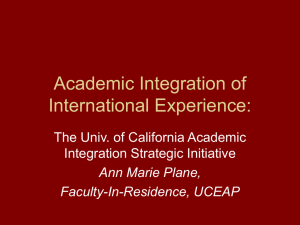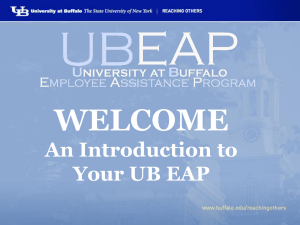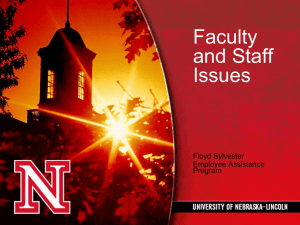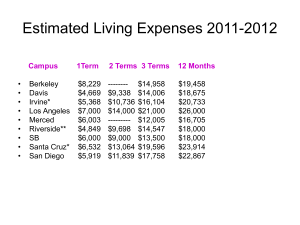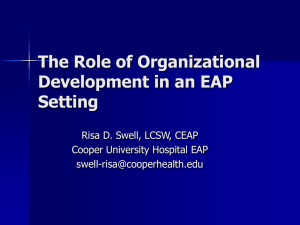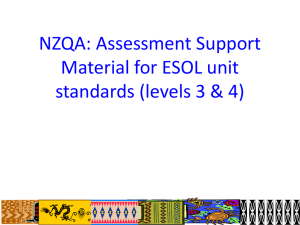Teacher/learner roles
advertisement
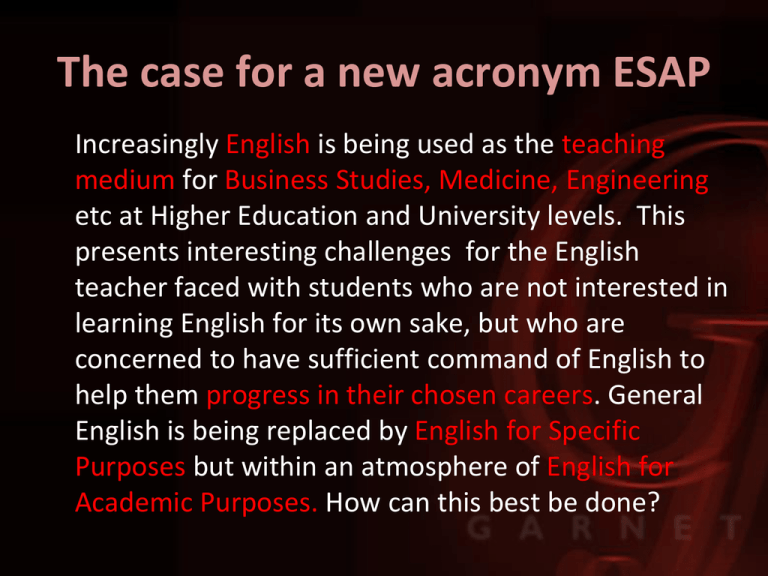
The case for a new acronym ESAP Increasingly English is being used as the teaching medium for Business Studies, Medicine, Engineering etc at Higher Education and University levels. This presents interesting challenges for the English teacher faced with students who are not interested in learning English for its own sake, but who are concerned to have sufficient command of English to help them progress in their chosen careers. General English is being replaced by English for Specific Purposes but within an atmosphere of English for Academic Purposes. How can this best be done? A general view • Language teachers lack the expertise and confidence to teach subject specific conventions and content • Skills and language across a range of disciplines remain the same General English Level driven: the main focus is on what a student can and cannot do now. Student motives are varied and general. They may be interested in the language or want to enjoy the global community. the specific view When English is taught, it should include: • current specific needs • wider needs (transferable skills and competencies) • acknowledgement of future needs • • What do students say? “We’ve been learning English for 6 years and we’re still doing the verb to be.” (Lack of interest / progression) “I’d like more time to speak and practise the language. I forget it straight after the lesson.” (Frustration) “Different teachers tell us different things. (Lack of faith in the teacher – or is it the book?) Which means ... • Students are generally goal-orientated. • Students might not know what they need, but they do know what they don’t need. • Our materials and methods should reflect this. The acronyms • • • • • • EFL? ENOP? ESP? EAP? ESAP? EOP? English study at university • • • • ENOP? EAP? ESP? ESAP? EAP provides … • Discourse structures and vocabulary spanning all academic fields • General skills to help decode and construct text in appropriate registers i.e., Bottom Up skills • EAP Themes based on areas of human knowledge – not quirky – not imaginary – not ‘one-off’ human interest stories – not ‘teen’ topics EAP Listening: Speaking: Reading: Writing: to lectures seminars, tutorials for research essays, assignments EAP LISTENING Listening and taking notes – not interactive listening – not ‘eavesdropping’ – not multiple listening – not ‘after doing’ comprehension questions How do we learn? • • • • • • • • • This seems like a simple ... • but there is no simple … • In the next two lectures, we’re... • to look at theories of … • This week, I’m going to talk... • theories from Ancient… • Next, theories from … • theory from a Russian scientist, …• ...agree about learning. • However... question answer going learning about Greece Islamic scholars Ivan Pavlov (contrary view) Top down bottom up listening How do we learn? This seems like a simple … but there is no simple … In the next two lectures, we’re … … to look at theories of … I’m going to talk about … … from Ancient … Next, theories from … A Russian scientist, … … agree about learning. However EAP SPEAKING Speaking from research – not phatic communion – not every function that can be thought of – not convergent, ‘what I know / think’ EAP READING Reading for research – not reading for pleasure – not every and any text type – not ‘after doing’ comprehension questions Researched Reading to Writing Researched Meaning into Rehearsed Words EAP WRITING Writing in academic genres – not first person – not informal postcards, letters – not convergent, ‘what I know / think’ EAP WRITING is: • analytical not impressionistic • objective not subjective • intellectual not emotional • serious not conversational • impersonal not personal • formal not colloquial Teaching writing: top down • • • • • Researching Structuring research notes Understanding models Organising information into paragraphs Writing topic sentences The TOWER of Production Thinking Organizing audience, purpose, content information from research, knowledge, opinion Writing appropriate writing plan Editing writing for the writer – cohesion Rewriting writing for the reader – coherence EAP Grammar We can start with a few facts ... 75% - 85% of EAP is in … … the present (including passives) 10% - 15% of EAP is in … … the past (including passives) 5% - 10% of EAP uses … … modals (Source: Various inc. Longman Grammar of Written and Spoken English) And ... 90% of EAP is in the simple aspect 7% of EAP is in the perfect aspect 3% of EAP is in the progressive aspect 0.5% of EAP is in the perfect progressive aspect (Source: Longman Grammar of Written and Spoken English) EAP Grammar the complex noun phrase clause joining clause embedding prepositional phrases stance adverbials EAP How does ESAP differ from EAP material? • Content-centred approach to promote more meaningful learning - teaches students to cope with input texts in their discipline (lectures, research articles, etc.) • Addresses variations within disciplines - different skills, conventions, lexis and register ESAP students need … TOP DOWN SKILLS to use specific information from the field to check and develop arguments and theories Building background knowledge enables ESAP English for Specific Academic Purposes • ESAP What background knowledge? • What is the discipline? • What are its branches? • What does a practitioner do? • What is the history of the discipline? • Who are the great people in the discipline – biography? • What are the great works in the discipline – references? • What are the basic principles / knowledge in the discipline? • What are the current issues? • What are the contentious issues? • Are there any Health and Safety issues (if relevant)? • How do you distinguish fact from opinion in the discipline? • What might the future hold? ESAP • Disciplinary variations: • Disciplines see reality in different ways ESAP Learning tasks • Humanities & social sciences Analysing & synthesizing from multiple sources • Science and technology Describing procedures, defining procedures, planning solutions ESAP Lexis and collocation • Common core ignores multiple meanings Consist means ‘stay the same’ in the social sciences and ‘composed of’ in the sciences Volume means “book’ in applied linguistics and ‘quantity’ in biology Abstract means ‘remove’ in engineering and ‘theoretical’ in social sciences ESAP Reporting conventions • Social sciences; • Verbs which refer to writing activities: discuss, hypothesize, suggest, argue • Engineers and scientists: • Verbs which refer to research activities: observe, discover, show, analyse, etc Self-mention (per 1,000 words) • • • • • • • • Philosophy Marketing Applied Linguistics Sociology Physics Biology Electrical engineering Mechanical engineering 5.5 5.5 4.5 4.3 4.1 3.4 3.3 1.0 Stance features (per 1000 words) • • • • • • • Philosophy Sociology App Ling Marketing Physics Mech Eng Elec Eng 42.8 31.1 37.2 39.5 25.0 19.8 21.6 Discipline Citations per 1000 words Biology Sociology Philosophy Applied Linguistics Marketing Electronic Engineering Physics Mechanical Engineering 15.5 12.5 10.8 10.8 10.1 8.4 7.4 7.3 Some implications for teaching.. • • • • • • Use target-language authentic texts Encourage analysis Encourage critical thinking Encourage reflection Use authentic models Use expert informants and .................... S What we teach in any kind of content based course is not the content itself but some form of the discourse of that content. ESAP should equip students with the vocabulary and skills they need to enable them to study their chosen discipline in the most effective way. Thank you ollytwist@garneteducation.com Basic content syllabus for ESAP courses What is the discipline? What are its branches? What does a practitioner in the discipline do? The history of the discipline The great people in the discipline – biography The great works in the discipline – references Basic principles / knowledge in the discipline Current issues in the discipline Contentious issues in the discipline Health and safety issues – if relevant Fact vs opinion in the discipline The future of the discipline Adapting the texts: Some features nouns prepositions or cataphoria its, their our -tion nouns passives noun C more common in academic English Some features pronouns not / no questions imperatives phrasal verbs progressive perfective less common in academic English = hypernyms, hyponyms = embedding in the noun phrase = alternative; definition / explanation = e.g. the problem + exposition = non-human reference = to avoid my = production, definition etc. = although still only 25% of total = e.g. the person that…; a way of doing etc. = EAP uses alternative nouns = EAP states positive propositions = except as rhetorical devices = although technical has many = Latinate words used instead = is doing, was doing etc. = has done, had done etc.

